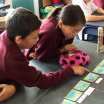Support understanding
Help ākonga to understand communication from others. This involves comprehension and making meaning from sounds, language, signs, body language, gestures and written information.
On this page:
On this page:
Current page section: Support understanding
Go to top of current page: Support understanding
Go to top of current page: Support understanding
Go to top of current page: Support understanding
Identify difficulties in understanding language
Identify difficulties in understanding language
Recognise and respond to the challenges created when students have difficulties understanding words and language.
Learners who have difficulty understanding may find it challenging to:
- follow instructions
- pay attention and listen
- respond appropriately to questions and requests
- use language through speech, sign or alternative forms of communication to communicate wants, needs, thoughts, and ideas
- form friendships and engage in positive social interactions
- understand body language
- understand what went wrong, especially in high stress situations
- complete tests, exams, and academic tasks in higher level education.
Check for understanding
Check for understanding
![11675 [Copy-of-CSP2555.png]](https://inclusive-live-storagestack-assetstorages3bucket-3uty0hejzw6u.s3.ap-southeast-2.amazonaws.com/public/inclusive-education/example-images/Copy-of-CSP2555__ScaleMaxWidthWzEwODZd.png)
Source: Ministry of Education | Te Tāhuhu o te Mātauranga
Reduce barriers to understanding
Reduce barriers to understanding
Suggestions to support understanding.
- Use visuals to give instructions or show a routine. Allow students to revisit and repeat key learning.
- Chunk instructions and use vocabulary that is familiar to students.
- Get the learner’s attention before speaking.
- Reduce classroom noise.
- Check understanding of key concepts and vocabulary and make connections with prior learning.
- Use graphic organisers to support thinking and planning.
- Allow for processing time.
- Ensure instructions are in the order they are to happen.
- Use microphones and sound systems when available, especially when talking to large groups, such as whole school assemblies.
Support understanding with visuals
Support understanding with visuals
Offer information in more than one way.
Use symbols and graphics to illustrate key concepts.
Keep the layout clean and uncluttered.

Source: CORE Education
Use visuals
Use visuals
Build a shared understanding of the meaning of visuals.
Some students may focus on unexpected parts of the image that you have not noticed, for example, items in the background.
- Make visuals of daily tasks, processes and steps.
- Use visuals that are relevant to the New Zealand context.
- Label resources with visuals, colours and text for easy identification.
- Make resources easy to find by using clearly divided zones, for example a maths resources zone.
- Use charts, visual calendars, colour-coded schedules, visible timers, and visual cues to increase the predictability of regular activities.
- Offer graphic organisers and flowcharts to break tasks into shorter chunks.
- Use visuals, social stories and video models to support learning of new skills or behaviours.
- Provide feedback in visual as well as verbal formats. Visual formats include written comments and things such as symbols and smiley faces.
Teach non-verbal communication
Teach non-verbal communication
- Help students learn to notice facial expressions and body posture during interactions. Highlight examples in stories, video clips, or use the emotions colour wheel.
- Role-play in small groups to practise recognising the meaning conveyed in postures and vocal intonations.
- Cue students to recognise common hand signs that are used in a classroom, such as recognising the palm facing forward to mean stop.
- Learn about how emojis and memes are used.
- Provide opportunities for students to watch short video clips with the sound off. Ask students what they think is happening by analysing the postures and the movements of the actors.
- Play charades or pantomimes and have students guess the message. This helps to draw attention to the meaning in body posturing.
Next steps
More suggestions for implementing the strategy “Key areas to support”:
-
Current page Support understanding
Return to the guide “Speech, Language and Communication”

Speech, Language and Communication
How to use this site
Guide to Index of the guide: Speech, Language and Communication
Strategies for action:
-
Identify needs and how to provide supportShow suggestions for Identify needs and how to provide support
-
Key areas to supportShow suggestions for Key areas to support
-
Helpful classroom strategies years 1-8Show suggestions for Helpful classroom strategies years 1-8
-
Helpful classroom strategies years 9-13Show suggestions for Helpful classroom strategies years 9-13
